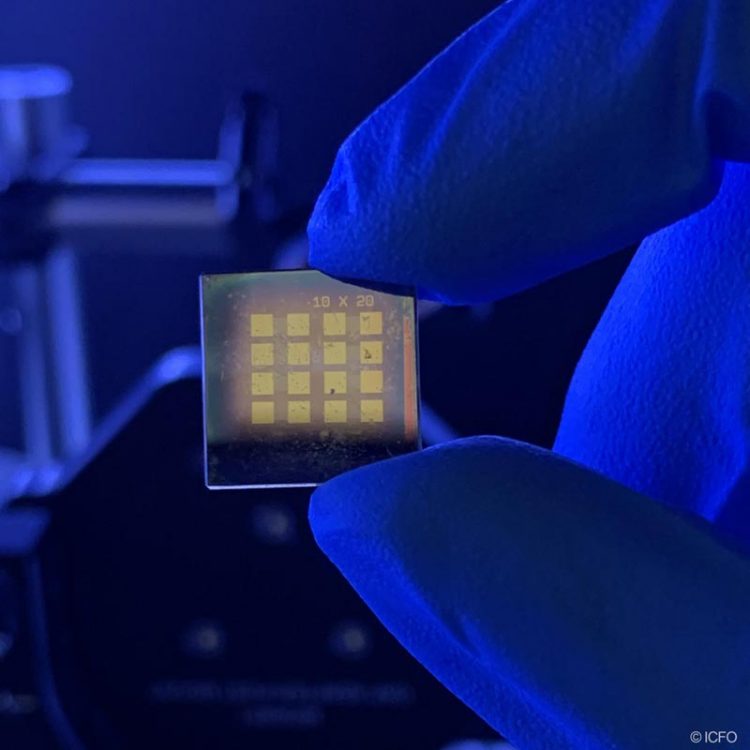Colloidal Quantum Dot Photodetectors can now see further than before

These are quantum dots coated on a transparent substrate with gold contacts for mid-infrared detection. Credit: ©ICFO
Even though there is a strong market need in bringing such functionalities to the consumer market, this would require a technology that is low-cost, CMOS compatible and does not impose severe regulatory concerns.
PbS Colloidal Quantum Dots (CQDs) have emerged as a cost-competitive and high performance photodetector technology, compatible with CMOS technology, which has demonstrated recently to be successful in the short-wave infrared (1-2 um).
However, so far, there has been a fundamental limit: such quantum dots have relied on interband absorption of light (photons excite carrier across the bandgap of the material) and as a result there is a lower energy limit that this technology can operate: the bandgap of the material.
In a study recently published in Nanoletters, ICFO researchers Iñigo Ramiro, Onur Ozdemir, Sotirios Christodoulou, Shuchi Gupta, Mariona Dalmases, Iacopo Torre, led by ICREA Prof. at ICFO Gerasimos Konstantatos, now report the development of a colloidal quantum dot photodetector that is capable of detecting light in the long infrared range, from 5 um – 10 um (microns), using PbS CQDs that, for the first time, are made with mercury-free material.
In their experiment, the researchers used a technique to electronically dope the quantum dots robustly and permanently. This heavy doping approach allowed them to enable a new regime for transitions of electrons: instead of relying on transitions across the bandgap of the material, they found a way to facilitate transitions amongst higher excited states, known as intersubband (or intraband) transitions.
By achieving this, they were able to excite electrons by absorbing photons with photon energies much lower than before in the mid and long wave infrared. They also demonstrated that the spectral coverage of such detectors can be tuned by changing the size of the dots, that is, the larger the quantum dots, the farther the absorption in the infrared.
The results of this study have reported a novel and unique material platform, based on heavily doped PbS CQDs covering a broad range of light, which could address and solve the challenges that the field of photodetector technologies is facing nowadays.
This newly discovered property of light absorption in the long infrared together with a low-cost and maturing CQD technology may bring about a revolution to extreme broadband as well as multispectral CMOS compatible photodetectors.
###
LINKS:
Link to the paper: https:/
Link to the research group led by ICREA Prof. at ICFO Gerasimos Konstantatos: https:/
Media Contact
All latest news from the category: Physics and Astronomy
This area deals with the fundamental laws and building blocks of nature and how they interact, the properties and the behavior of matter, and research into space and time and their structures.
innovations-report provides in-depth reports and articles on subjects such as astrophysics, laser technologies, nuclear, quantum, particle and solid-state physics, nanotechnologies, planetary research and findings (Mars, Venus) and developments related to the Hubble Telescope.
Newest articles

Properties of new materials for microchips
… can now be measured well. Reseachers of Delft University of Technology demonstrated measuring performance properties of ultrathin silicon membranes. Making ever smaller and more powerful chips requires new ultrathin…

Floating solar’s potential
… to support sustainable development by addressing climate, water, and energy goals holistically. A new study published this week in Nature Energy raises the potential for floating solar photovoltaics (FPV)…

Skyrmions move at record speeds
… a step towards the computing of the future. An international research team led by scientists from the CNRS1 has discovered that the magnetic nanobubbles2 known as skyrmions can be…





















